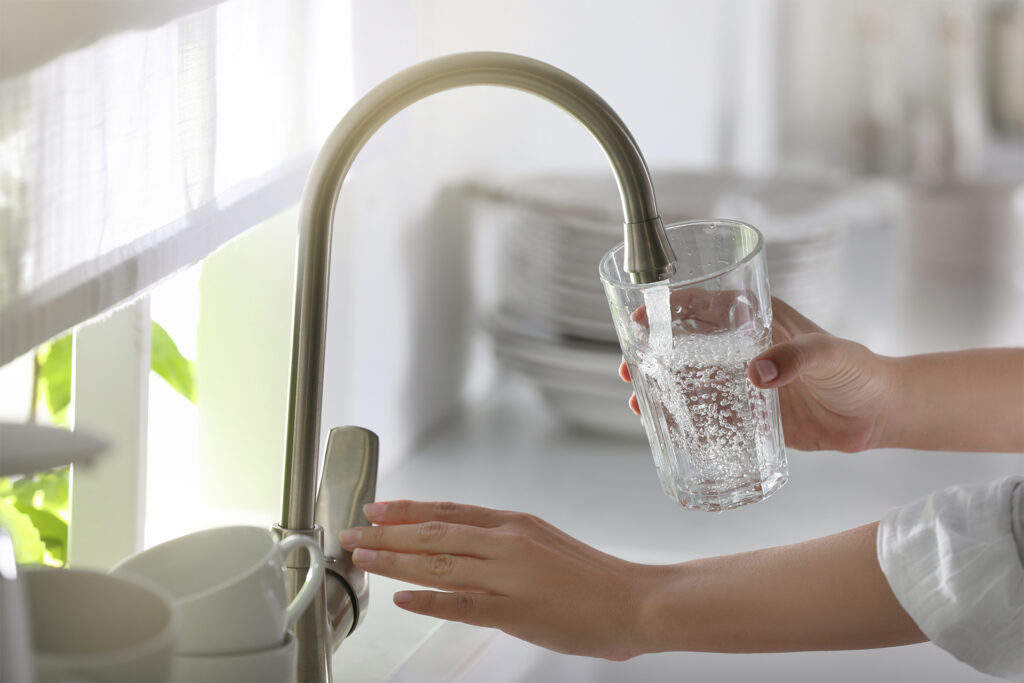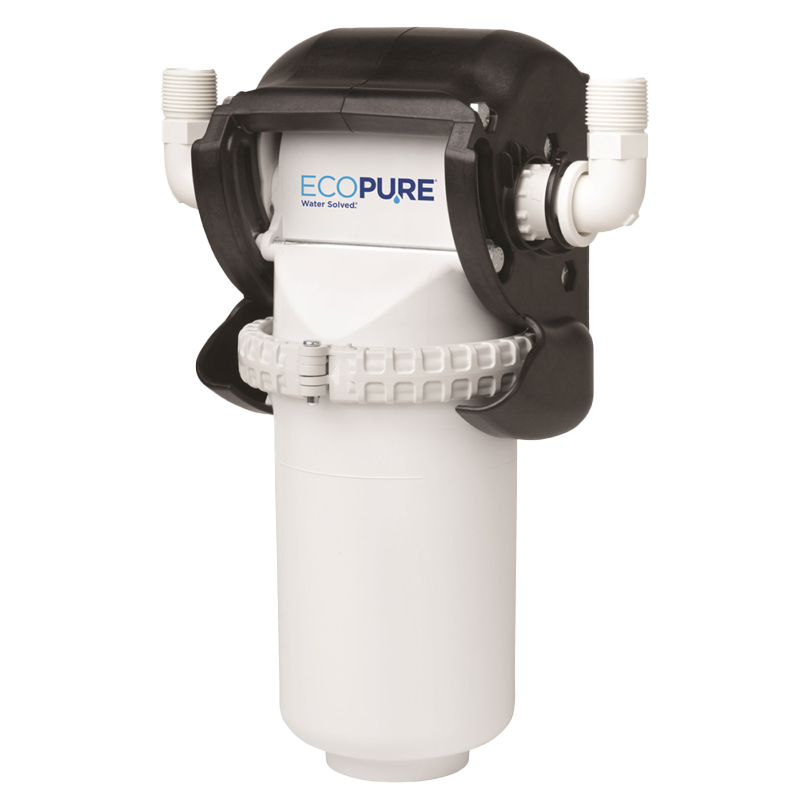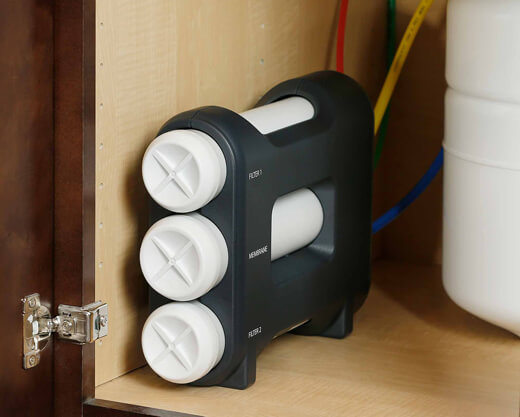What’s Best: A Whole-House or Under-Sink Water Filter?
If you are asking yourself, “what kind of water filtration system do I need?” You are in the right spot. When considering the best water treatment system for home use, choosing between whole-house filtration or an under-sink filtration system is often a key part of the decision. Both types of systems have their advantages and, in some instances, it’s ideal to have both in your home.
This guide can serve as a starting point, highlighting many of the key differences and benefits among the system options to help you discern which system choice may be ideal for your filtration needs.

What’s the Best Type of Water Filtration System?
Your home’s water—whether it comes from a well or municipality—could be impacted by contaminants that vary in severity. Some contaminants are nuisances, doing little more than affecting taste or smell, but others can harm you if consumed in large quantities. The purpose of adding a water filtration system to your home is to filter and reduce contaminants. Each water filtration system is designed to reduce specific contaminants, and some systems reduce more contaminants than others. Although water filtration systems are not created equally, they all are meant to provide you with better water.
To determine the best water treatment system for your home, you need to know what’s impacting your water. A good starting point is referencing the Environmental Working Group’s Tap Water Database. This resource can be used to reference what water threats members of your community are facing. After looking at the database, you should contact a Water Pro who can test your water.
Whole-House Water Filtration
Whole-house water filtration is how it sounds; it’s a point-of-entry filtration method that treats water throughout your home. These systems are installed on your main water line, before the water heater, and are your first line of defense against water contaminants. Because you are filtering water for your entire household, whole home water filters are designed to target particulates, and taste and odor issues. Some whole-house water filtration systems have two-in-one capabilities, doubling as water softeners. For homes on municipal water that can benefit from soft water and chlorine reduction, a hybrid system may be your best solution.
Benefits of whole-house water filtration include:
- Reduce contaminants throughout the home at point of entry
- Filtered water at all faucets and showerheads
- Great for well water issues, like sediment and iron
- Systems with carbon filtration improve taste and smell of water
Most whole-house filtration systems are designed with an open housing that you pair with a drop-in filter cartridge of your choice. These filter cartridges are universal in size, giving you the ability to try different types for a truly customizable solution.
And maintenance is pretty quick and simple, too. Depending on your home water quality, filter cartridges usually last three to six months, and you will know when to replace them when your water pressure sharply decreases. This drop-off indicates your filter has captured a level of contaminants where the water can no longer pass through easily.
If regular filter changes sound like one more thing to remember, there are whole-home filtration systems that don’t require filter changes. These systems do the work for you by automatically cleaning themselves at the cadence you set.
Discover a filtration system that meets the needs of your whole home.
Explore whole-house systems that reduce water contaminants at every faucet.
Whole Home Filtration Systems

Under-Sink Water Filtration
Under-sink or point-of-use systems are installed in a kitchen or bathroom. They connect to your under-sink plumbing and are convenient, cost-effective solutions for reducing a variety of more serious contaminants in your drinking water, including ones you can’t see, taste or smell.
Under-sink systems typically allow water to pass more slowly through the filter(s) than whole home filtration, capturing much smaller contaminants like lead, PFAS, nitrate, and arsenic. This thoroughness does impact the water flow rate and is why you’ll often see under-sink systems come with a dedicated faucet for the filtered water to dispense from.
Benefits of under-sink filtration include:
- Reduce contaminants at one faucet in the home
- Ideal solution for drinking and cooking water safety concerns
- Improve taste, smell, and reduce more serious contaminants in your water
- Can replace buying bottled water
- Take up minimal space, as they fit under a kitchen or bathroom sink
Many under-sink filtration systems today come with everything you need for a do-it-yourself installation, like these popular two- or three-filter systems that can be installed in an afternoon. The installation kits for these systems come with color-coded tubing making following along with the step-by-step instructions a snap.
To keep your drinking water as safe and clean as possible, it’s important to maintain the system with recurring filter changes. Today’s drinking water filtration systems are often designed with encased filter cartridges, which keep the captured contaminants away from you and allow you to replace the filters with just a simple twist. Replacement filters typically last up to six months, and some systems even include technology that indicates when filters need to be changed.
With the cost of the system, plus regular filter changes, you may be wondering, ‘how is this better than bottled water?’ While bottled water may be a convenient, on-the-go option, point-of-use filtration systems outshine bottled water in both cost savings and environmental impact. And in many instances, the water from your under-sink system is also safer than what comes bottled. Need more proof? We break it all down here.
Thinking an under-sink system is your best option?
See a range of systems to get the ideal water filtration solution that installs right under your kitchen or bathroom sink.
Under-Sink Filtration
Why Having Both a Whole-House and Under-Sink Water Filtration System May Be Best
If you are someone who faces a variety of contaminants in your water, the best water treatment system for your home may be having both a whole-house and under-sink filtration solution installed. Combined, the two can provide greater protection than using just one type of system. We highly recommend this option for homes with well water, as sediment and iron will be captured by the whole-house system before it contacts the under-sink system, protecting the longevity and effectiveness of the under-sink filters.
Water filtration systems, and under-sink systems in particular, also pair well with water softeners. For those who don’t like the taste of soft water, or are concerned about the sodium level in soft water, filtered water is a great way to improve taste and reduce the sodium. But before you start making purchases, and looking at do-it-yourself projects, test your water to know exactly what your home water is facing.